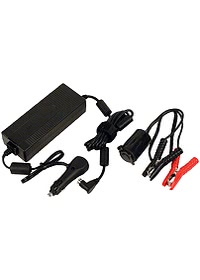archangle wrote:Now that I've got the jump starter, I do realize one limitation with this jumper and some other somewhat similar ones for emergency use.
Some people think they'll get a charger like this, use it during the night during a power outage and then recharge it by running a generator or taking it somewhere during the day.
One thing many of these jumper units take quite a while to recharge. I ran my Diehard unit down about half way yesterday, and it's taking over 8 hours to recharge. It's currently showing 72% charge after charging all night long.
Also, as with most units, the percent of charge indicator is not particularly reliable. I put a 12V 60W DC trouble light on it last night and the readout said about 50% charge remaining. However, when I hooked it up to the power supply, it showed 33% as it started charging.
It's still useful. You just have to realize that the charging circuit it has is for handling a short outage with a day or so to recharge between usage.
This applies as well to some of the deep cycle systems as well. Many of the smart chargers that can be left hooked up to the battery all the time only charge the battery slowly, especially if it's deeply discharged. If you want to use it with a generator running a short time period during the day, you're going to need a more powerful rapid charger, such as a car battery charger that is not suitable for staying connected to the battery 24/7.
Comments,
So the lesson from the above post by ArchAngel is that all those ideas about using batteries for back-ups are conditioned that they are usefull for only one night during a power stoppage. This is b/c using them for 6 to 7 hours would deplete the batteries close to the minimum allowed limit. If the power stoppage lasts for another night, there would not be enough charge left to run an XPAP for 6 to 7 more hours. But after the power resumes then it could take some 72 hours to recharge the battery and get it ready for the next stoppage.
I got similar results testing my new Diehard JumpStarter #1150 :
http://www.sears.com/diehard-platinum-p ... ckType=G22
The machine was charged at Sears before I picked it up.
After it was charged for additional 12 hours to 100%, I stopped the charging and I plugged a 40 Watt bulb into the 110 Volt AC outlet of the inverter. 40 watts could run an S9 Autoset or S9 Elite, for 8 hours, but without the humidifier.
As soon as the bulb started to light, an inner fan began to make noise as hi as a running dishwasher (about 50 dB). The voltage at the inverter outlet was 113 volt AC. About this noise I thought that it could be possible to place the machine in a room by itself and run an extention cord to the bedroom.
After about 4 hours of running (lighting the bulb) , the voltage at the inverter outlet dropped from 113 volt to 106 volt.
After another 30 min the bulb stopped lighting and the machine started to emit a hi pitch ear piercing sound, probably an alarm of being over discharged.
One more test could show some better results. It's connecting the 12 Volt DC output from the JumpStarter directly to the S9 Autoset without using the built-in inverter. This requires a cable and converter like the following which costs about $85:
DC Converter 24V/90W For S9™ Machines
(No use for the alligator clamps)











